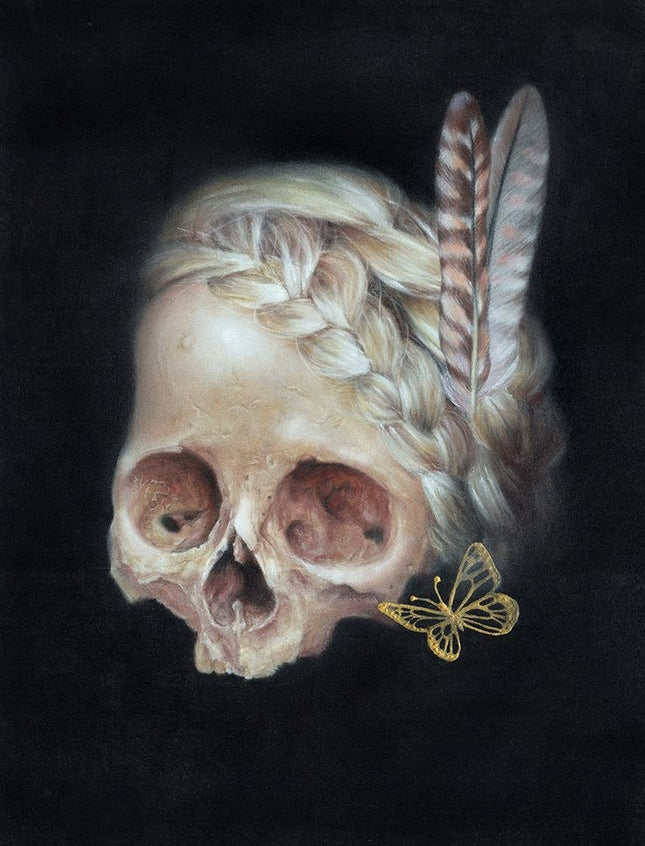
Tribal Druid & Native

Bec Winnel Harriette Giclee Print by Bec Winnel
Harriette Giclee Print by Bec Winnel Artwork Limited Edition Print on Fine Art Paper Graffiti Pop Street Artist. 2014 Signed & Numbered Limited Edition of 25 Artwork Size 8x10.25 Female Skull with Blond Hair & Feather. Introducing "Harriette" by Bec Winnel Bec Winnel's "Harriette" is a giclée print that captivates the viewer with its haunting beauty and intricate detail. This 2014 creation is part of a limited edition series of 25, each piece signed and numbered by the artist, with dimensions of 8x10.25 inches. The artwork's subject, a female skull adorned with blonde hair and a feather, is not just an exploration of mortality but a deeper delve into the themes of ephemeral beauty and the intersection of life and death. The Ethereal Aesthetics of Winnel's Portraiture Winnel is renowned for her ability to capture the essence of her subjects with a palpable tenderness. In "Harriette," juxtaposing a lifeless skull with vibrant, lifelike hair and a delicate feather creates a stark, unsettling, and beautiful contrast. This contrast is heightened by the presence of a butterfly—a symbol of transformation and rebirth—hinting at the cycle of life and the inevitability of change. The artwork is a testament to Winnel's mastery of mixed mediums, as she employs pastel, pencil, watercolor, and metallic elements to build up layers of texture and color. This layering technique results in a soft, almost otherworldly visual experience characteristic of her style. The gentle gradations and the meticulous attention to detail in "Harriette" invite the viewer to ponder the transient nature of beauty and the permanence of art. Street Pop Art and Graffiti Influences While Winnel's work traditionally occupies the space of fine art, the limited edition nature of "Harriette" and its striking visual impact resembles the ethos of street pop art and graffiti. Like street artists' fleeting yet powerful statements, "Harriette" commands the viewer's attention; its limited availability adds to its allure and value. The work engages with pop culture's fascination with the macabre and the beautiful, combining them in a way that would not be out of place on the walls of a metropolitan alley or a modern art museum gallery. Winnel's artistry blurs the lines between traditional portraiture and the rebellious spirit of street art, creating pieces that are both accessible and profound. Reflections on Femininity and Mortality "Harriette" reflects Winnel's ongoing exploration of femininity, romanticism, and nature. The skull, void of life yet adorned with symbols of beauty and nature, speaks to the complex relationship between life's fragility and the enduring nature of feminine spirit. Winnel's choice to blend these elements against a dark background further accentuates the subject, emphasizing the recurring theme of emerging and fading in her works. This piece is more than a simple portrait; it is a narrative of life's delicate balance, a commentary on the dichotomy between the temporal and the eternal. Winnel's exploration of aesthetic nostalgia is evident in the work's vintage feel, reminiscent of a time when such representations were common in literature and art, intended to remind of life's impermanence. Bec Winnel's "Harriette" is a compelling piece that encapsulates the artist's signature style while engaging with broader themes prevalent in pop and street art. It is an artwork grounded in the fundamentals of fine art yet speaks a language that resonates with the contemporary viewer, bridging the gap between different art forms and periods. Through "Harriette," Winnel invites us into a contemplative dialogue about beauty, life, and the legacies we leave behind.
$100.00


